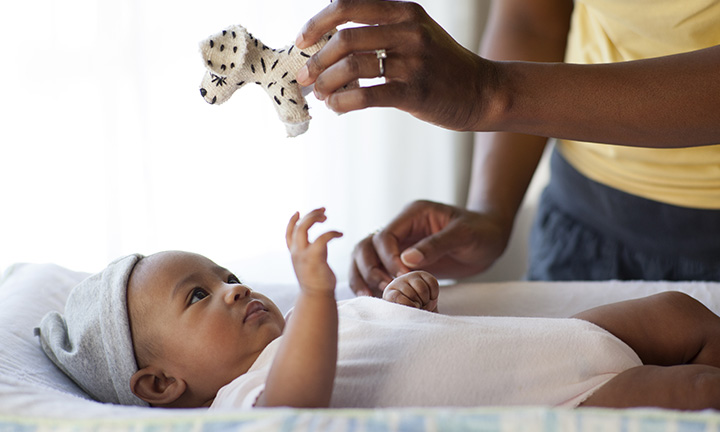
When Do Babies Roll Over? How to Encourage It


Wondering “When do babies roll over?” Most infants begin to roll over between 4 and 7 months of age, though some may show signs as early as 3 months. This milestone typically starts with rolling from tummy to back, followed by back to tummy a few weeks later. Key signs your baby is getting ready to roll include stronger neck and arm muscles, more time spent on their tummy, and increased curiosity about their surroundings.
Here’s a quick overview of typical rolling milestones:
4–5 months: May start rolling from tummy to back
5–7 months: Often begin rolling from back to tummy
By about 7 months: Most babies can roll both ways confidently.
Keep in mind, every baby develops at their own pace. If your baby isn’t rolling by 6 months, it’s worth discussing with your pediatrician. In this article, we’ll explore how to support your baby’s development and encourage safe rolling.
When Do Babies Start Rolling Over? Key Developmental Stages to Watch for
You may be wondering, “When do babies start to roll over?” and “What age do babies roll over?” Rolling over usually occurs between 4 and 7 months of age. However, every baby is unique and may reach this milestone at a different time, as their development progresses at their own pace.
The “rolling over” milestone starts with a few noticeable signs of development. At around 5 months old, your baby may start to show the following signs that rolling over is on the horizon:
Using their arms to lift their chest and arch their back
Rocking on their stomach
Kicking or twisting their legs
Swimming with their arms.
Developing these kinds of gross motor skills is necessary for your baby to be able to eventually roll over.
While it’s uncommon for a baby to start rolling over before reaching 4 months, it's not entirely impossible. On the other hand, if your baby isn’t rolling over by 5, 6, or even 7 months, don’t be discouraged. Every baby develops at their own pace. Be patient and look for the signs of readiness listed above—there's still plenty of time for your baby to reach this milestone.
When Do Infants Roll from Tummy to Back?
You can’t predict when your baby will start rolling over, as this varies from child to child; however, rolling over from their tummy to their back is often a baby’s first success, typically around 4 to 5 months. But when do babies roll from back to stomach? That skill typically comes a bit later. Here’s why:
Rolling from belly to back is easier because it only needs a small change in gravity.
Rolling from back to belly requires more complex movements, like rocking, arching the back, and twisting the legs.
When Do Babies Roll from Back to Belly?
Just like rolling from belly to back, you can’t predict the exact age at which your baby will do this. However, it’s common for babies to roll over in both directions by about 7 months of age.
How to Help Your Baby Roll Over: Tips and Techniques
Babies learn by playing and exploring, so what seems like a teaching moment to you will seem like a fun game to them. Take this as an opportunity to encourage their physical development.
So, how do you teach your baby to roll over from tummy to back? The answer is tummy time! It’s an activity that you can start when your baby is a newborn infant. Encourage rolling over by placing your baby on their tummy for short periods while awake, with you close at hand. Eventually, you may start seeing your baby rolling over from tummy to back.
Here are some tips for encouraging rolling over during tummy time:
Have a dedicated space for tummy time. A good place can be on a blanket spread out on the floor.
Do tummy time two to three times a day for three to five minutes at a time. As your baby gets used to this new activity, you can increase the time and frequency.
During tummy time, encourage your baby to roll over by showing them a favorite toy/rattle or a mirror, or by making noises. You could also lie side by side with your baby and encourage them to roll over. But avoid pushing or pulling them. Congratulate your baby once they’ve managed to roll over.
Make sure not to leave your baby unattended during tummy time, and don't let them play with any small toys or objects as these can be a choking hazard.
Keep Your Baby Dry While They Roll
As your baby becomes more active—especially once they start learning how to roll over—it’s important to keep them comfortable during naps, tummy time, and overnight sleep. A great diaper can help your little one stay dry and happy, even through all that movement. Pampers Swaddlers are designed to keep your baby up to 3x drier* for comfort all day and night, helping to protect delicate skin while they explore new skills. With an absorbent liner that locks away wetness, a soft, snug fit with All-Around LeakGuard to stop leaks from every angle, and a wetness indicator that lets you know when it’s time for a change, Pampers Swaddlers offer gentle support during every wiggly stage. They’re also hypoallergenic, free of chlorine, parabens, and latex, and dermatologist-approved by the Skin Health Alliance—so you can feel confident in what touches your baby’s skin. (*vs size 4 leading value brand)
How to Keep Your Baby Safe When They’re Rolling Over
As your baby develops new skills, keep a close eye on them, especially on high surfaces like changing tables, beds, or sofas. Always keep a hand on them to prevent falls.
It's never too soon to baby-proof your home, especially as your little one begins to explore. If you haven't already, consider installing a baby gate and securing furniture that could tip over.
Even though your baby may be rolling over, be sure to put your baby on their back when placing in the crib or bassinet.
What to Do If Your Baby Isn’t Rolling Over: Warning Signs & Next Steps
If you’re wondering when babies “should” roll over, your little one may reach certain milestones sooner than others, or they may take a little extra time to master certain skills. This is normal—every baby is an individual and develops at their own speed.
Your baby's healthcare provider will be tracking your baby's growth and development. If you're concerned your baby hasn't rolled over, you think your baby has stopped rolling over, or you have any other concerns about your baby’s development, ask your provider at your next appointment.
How Tummy Time Helps Babies Build Muscle for Rolling Over
As we mentioned above, tummy time plays a vital role in helping babies develop the muscles necessary for rolling over. By spending time on their stomachs while awake, babies strengthen their neck, shoulders, arms, and core muscles, which are all crucial for rolling.
Wondering when you should start tummy time? Experts recommend starting tummy time as early as the newborn stage for short, supervised sessions to gradually build strength. This positioning encourages babies to lift their heads and push up, building the muscle coordination they need for important milestones like rolling over.
Other Developmental Milestones to Watch for
Seeing your baby reach the “rolling over” milestone is an exciting moment. Throughout your little one’s infancy, you’ll watch many skills develop as they reach various milestones. Here are some physical developmental milestones you’ll likely see in your baby’s first year or two:
Remember, each baby reaches these milestones at their own pace, but if you have any concerns about your little one’s development, contact their healthcare provider.
FAQS AT A GLANCE
Babies generally don’t start to roll over until 4 months of age, which means seeing your baby rolling over at 2 months may be unlikely since they haven’t yet developed the strength to be able to do so. However, since every baby is different, there may still be a chance for developing this “rolling over” milestone earlier.
Consult your healthcare provider for additional advice on your baby’s development and keep reading for more information.
The Bottom Line
Giving your baby daily, supervised tummy time while awake is a great way to help build the strength and coordination needed for rolling over, sitting up, crawling, and eventually walking.
Whether your baby has already mastered rolling over or is still getting the hang of tummy time, it’s good to be on top of your baby’s physical development. Before you know it, your little one will be having a great time rolling around, getting up, and running around the house.
When exactly your baby will first roll over isn’t certain, but what is certain is that you’re sure to be going through a lot of diapers around this time. To earn Pampers cash for your Pampers diapers purchased, download the Pampers Rewards app today!
- American Academy of Pediatrics. Caring for Your Baby and Young Child: Birth to Age 5, 7th ed. (New York: Bantam Books, 2019).
- Mayo Clinic. Guide to Your Baby’s First Years, 2nd ed. (Rochester, MN: Mayo Clinic Press, 2020).
- Healthy Children. “Movement Milestones: Babies 4 to 7 Months.”
- Kids Health. “Movement, Coordination, and Your 4- to 7-Month-Old.”
- Kids Health. “Tummy Time.”
- Mayo Clinic. “Infant and Toddler Health: Infant development: Birth to 3 months.”
- Mayo Clinic. “Infant Development: Milestones from 4 to 6 months.”
Read more about Baby
Related Articles
Join a World of Support
through Pregnancy and Parenthood.
TRACK WITH TOOLS
LEARN WITH EXPERTS
GET REWARDED














